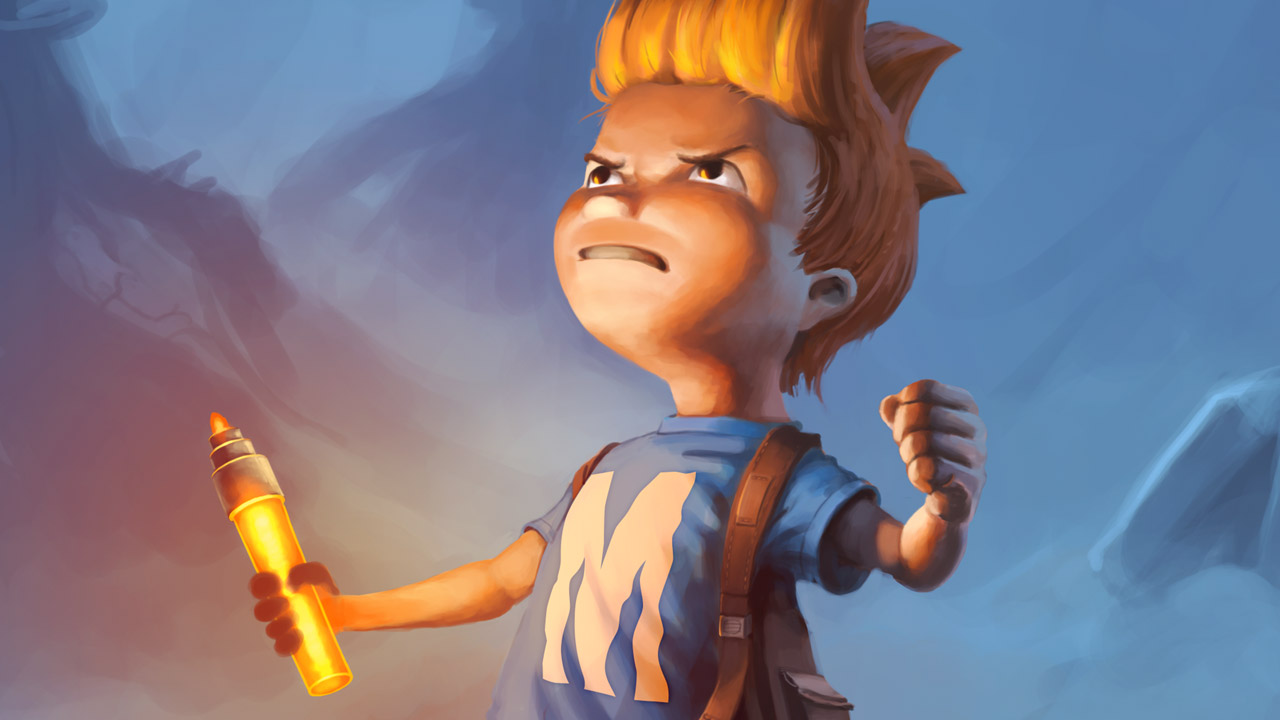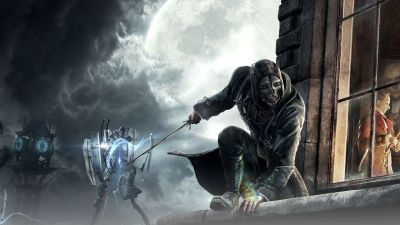Admit it: being a big brother sucks sometimes, especially when your kid brother goes into your room, plays with your toys, and then goes and breaks them. Sometimes you wish he would just disappear.
That’s exactly what happens to Max one day, when he comes home from school to find his little brother Felix smashing up his stuff. A quick online “Giggle” search provides Max with a spell which, when he reads it aloud, opens up a mysterious portal in his room. A giant, hairy claw emerges from within, seizes Felix, and pulls him through the portal. Determinedly, Max rushes through the portal after his brother, because we all know that even though siblings are a royal pain the butt, we do really love them at the end of the day.
Thus begins young Max’s second adventure, Max: The Curse of Brotherhood. We were first introduced to Max in 2010, when he starred in Max & the Magic Marker. This second game retreads a lot of the same ground as the first, but still manages to warrant its existence.
The Curse of Brotherhood has a marginally darker feel to it than the original (wishing your brother would disappear is a little mean, after all). Press Play has kept the light and airy gameplay, and the writing is suitable for all ages, but the themes it works with in the sequel - brotherhood, sibling rivalry, the strength of the familial bonds - sometimes see the story veering into more mature territory, even when the characters are pratfalling and slapsticking their way around your screen.It’s still perfectly suitable for youngsters of course, but adults with experience of the first game are likely to notice that the writing feels more mature. Max and the Magic Marker rarely strayed beyond the bright and cheery with its exposition, and it feels almost as though its sequel is just as much a sign of the developer growing up as it is Max’s journey out of childhood and towards adolesence.
With the greater power afforded by modern PCs and the current crop of consoles, its difficult not to draw parallels with Pixar or Dreamwork’s movies when it comes to the visuals. Character models and soft lighting strongly evoke the likes of Toy Story or How to Train Your Dragon, the animation is charming and lively, and while there’s not much dialogue to speak of the story is conveyed tightly and succinctly.
At its core, The Curse of Brotherhood is a puzzle-platformer just like its predecessor. To start with, you’re led through Max’s 2.5D world without any additional powers, allowing you to get used to controlling our hero as he runs, jumps, and crawls after the horrible monster that is carrying his brother away for some unspeakable purpose. 2.5D worlds aren’t unique in the gaming industry, but The Curse of Brotherhood’s ability to render 2D images in a way that causes the eye to believe it is looking at a 3D image lends some visual complexity to an otherwise simple game.
Where The Curse of Brotherhood differs from so many other games though is in its mechanics. After a mysterious old woman imbues Max’s dried-out magic marker with her powers, you’re able to control the most basic element in the world: earth. Whenever you see a glowing orange object on the ground, you can manipulate your environment by raising or lowering platforms, enabling you to trap enemies and reach inaccessible platforms. As the game goes on, your power over the environment increases, which leads to ever more complex situations which require quick thinking - and reflexes - to overcome.
There are five powers in total: creating earth platforms (orange), creating sticks (green), creating vines (yellow), creating water spouts (blue), and creating magic fire (purple). In the early stages, powers are generally used separately from one another but as the game progresses and the puzzles become more complicated, it is necessary to either chain powers together in a series of perfectly placed, well-timed jumps, or by linking powers together and chaining a vine, a branch, and a vine in order to swing across a particularly large gap.
Despite this gradual ramping up, the game does have a tendency to feel formulaic. When Max gains a new ability, you’re are given a brief tutorial of how to use his new power, only to see the game predictably require its use in almost every subsequent puzzle. The charming presentation and script will keep you going though. While The Curse of Brotherhood is simple when it comes to its background story and gameplay, the overall package is polished and playable enough to make you want to see it through to the end.
Don’t let it’s kid-friendly appearance deceive you though: a few frustrating difficulty spikes are likely to test the patience of any veteran gamer. We reached a point, on multiple occasions, where the urge to rage quit swelled because we could not jump from the water spout to the swinging vine at just the right time in order to swing over the jet of hot lava and land on the precariously small platform that began to crumble as soon as we set foot on it. The words and expressions we used during these moments were certainly not kid-friendly. We would have been very interested if the developers had included a death counter, because we’re pretty sure that we sent poor Max to his untimely demise at least 250 times before finally reaching the end credits. Luckily, Brotherhood implements a check-point feature that does a pretty decent job of respawning you close to where you met your end. It’s not perfect though - there were a few occasions where we had to start further back than we liked and had to redo a particularly challenging puzzle all over again .
With only seven stages, Max: The Curse of Brotherhood isn’t a long game, and if you are quick on the uptake and find the puzzles relatively easy, it shouldn’t be too long before you see the end credits. Longevity is boosted by two collectible quests which require the player to find a secret area hidden in certain stages, or make a slight detour here and there, but these are secondary to the overarching story line.
The most enjoyable aspect about Brotherhood is the polished and attractive visuals on display. Even on Xbox 360, Max’s world is stunning - filled with lush forests, searing deserts, dark and scary underground caves, and hot lava. The sound work is equally accomplished; the voice actors perform their roles with infectious enthusiasm, and the background music - while not particularly original in its execution - does a good job of adding dramatic impact to each situation.
Despite its difficulty, Max: The Curse of Brotherhood is perhaps better suited toward the 10 year old crowd. Not because it’s a “kids game”, but maybe because we have lost some of our child-like intuitive nature, and we were frustrated by our adult mind when we really should have been tapping into our inner middle-school student. Or, perhaps we’re just terrible at platformers.
Either way, despite its occasional frustrations and short length there’s a lot to love about The Curse of Brotherhood. It doesn’t drastically evolve the template laid down by its predecessor, but the gorgeous presentation and some wonderful level design will hold your interest for the 5-6 hours it takes to reach its conclusion. We’d love to see more of Max in the future - we just hope for something a little more progressive next time.



